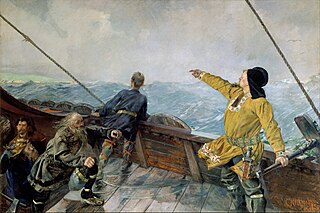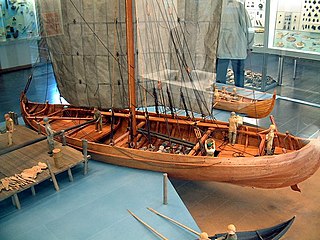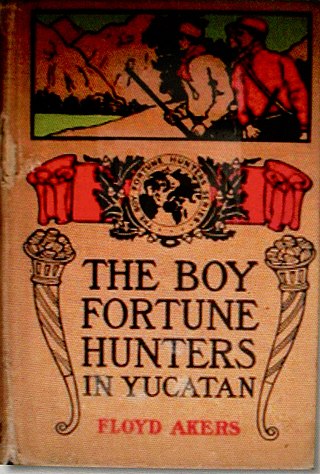
Vinland, Vineland, or Winland was an area of coastal North America explored by Vikings. Leif Eriksson landed there around 1000 AD, nearly five centuries before the voyages of Christopher Columbus and John Cabot. The name appears in the Vinland Sagas, and describes Newfoundland and the Gulf of Saint Lawrence as far as northeastern New Brunswick. Much of the geographical content of the sagas corresponds to present-day knowledge of transatlantic travel and North America.

Leif Erikson, also known as Leif the Lucky, was a Norse explorer who is thought to have been the first European to set foot on continental America, approximately half a millennium before Christopher Columbus. According to the sagas of Icelanders, he established a Norse settlement at Vinland, which is usually interpreted as being coastal North America. There is ongoing speculation that the settlement made by Leif and his crew corresponds to the remains of a Norse settlement found in Newfoundland, Canada, called L'Anse aux Meadows, which was occupied approximately 1,000 years ago.

Freydís Eiríksdóttir was an Icelandic woman said to be the daughter of Erik the Red, who figured prominently in the Norse exploration of North America as an early colonist of Vinland, while her brother, Leif Erikson, is credited in early histories of the region with the first European contact. The medieval and primary sources that mention Freydís are the two Vinland sagas: the Saga of the Greenlanders and the Saga of Erik the Red. The two sagas offer differing accounts, though Freydís is portrayed in both as a strong woman.
Gudrid Thorbjarnardóttir was an Icelandic explorer, born at Laugarbrekka in Snæfellsnes, Iceland.

The Saga of Erik the Red, in Old Norse: Eiríks saga rauða, is an Icelandic saga on the Norse exploration of North America. The original saga is thought to have been written in the 13th century. It is preserved in somewhat different versions in two manuscripts: Hauksbók and Skálholtsbók.

Skræling is the name the Norse Greenlanders used for the peoples they encountered in North America. In surviving sources, it is first applied to the Thule people, the proto-Inuit group with whom the Norse coexisted in Greenland after about the 13th century. In the sagas, it is also used for the peoples of the region known as Vinland whom the Norse encountered and fought during their expeditions there in the early 11th century.

Helluland is the name given to one of the three lands, the others being Vinland and Markland, seen by Bjarni Herjólfsson, encountered by Leif Erikson and further explored by Thorfinn Karlsefni Thórdarson around AD 1000 on the North Atlantic coast of North America. As some writers refer to all land beyond Greenland as Vinland; Helluland is sometimes considered a part of Vinland.

Thorfinn Karlsefni Thórdarson was an Icelandic explorer. Around the year 1010, he followed Leif Eriksson's route to Vinland in a short-lived attempt to establish a permanent settlement there with his wife Gudrid Thorbjarnardóttir and their followers.

A knarr is a type of Norse merchant ship used by the Vikings for long sea voyages and during the Viking expansion. The knarr was a cargo ship; the hull was wider, deeper and shorter than a longship, and could take more cargo and be operated by smaller crews. It was primarily used to transport trading goods like walrus ivory, wool, timber, wheat, furs and pelts, armour, slaves, honey, and weapons. It was also used to supply food, drink, weapons and armour to warriors and traders along their journeys across the Baltic, the Mediterranean and other seas. Knarrs routinely crossed the North Atlantic carrying livestock such as sheep and horses, and stores to Norse settlements in Iceland, Greenland and Vinland as well as trading goods to trading posts in the British Isles, Continental Europe and possibly the Middle East. The knarr was constructed using the same clinker-built method as longships, karves, and faerings.

Grœnlendinga saga is one of the sagas of Icelanders. Like the Saga of Erik the Red, it is one of the two main sources on the Norse colonization of North America. The saga recounts events that purportedly happened around 1000 and is preserved only in the late 14th century Flateyjarbók manuscript.

Vinland, published in 1992 by George Mackay Brown, is a historical novel set in the Orkney Islands in the early 11th century. It derives its name from a voyage the protagonist takes to that faraway land in the west.

Vinland Saga is a Japanese historical manga series written and illustrated by Makoto Yukimura. The series is published by Kodansha, and was first serialized in the boys-targeted manga magazine Weekly Shōnen Magazine before moving to Monthly Afternoon, aimed at young adult men. As of June 2024, its chapters have been collected in 28 tankōbon volumes. Vinland Saga has been licensed for English-language publication by Kodansha USA. The story is a dramatization of the story of Thorfinn Karlsefni and his expedition to find Vinland, with the majority of the story covering his fictional counterpart's transition from a bloodthirsty, revenge-filled teenager into a pacifistic young man; juxtaposed against this is the rise to power of King Canute, the journey of his own counterpart directly contrasting with that of Thorfinn's.
They Came on Viking Ships is a children's historical novel by Jackie French, first published in Australia in 2005. In 2007 it was retitled as Slave Girl for its publication in Britain, and Rover for its publication in the United States.
The Viking Trilogy is a trilogy of juvenile historical novels by Henry Treece.

Troll Fell is a children's fantasy novel written by Katherine Langrish, the first in the Troll Trilogy which comprises Troll Fell, Troll Mill and Troll Blood. It is set in Viking Scandinavia and is centred about the eponymous mountain, which is infested with trolls.

Troll Mill is a children's fantasy novel written by Katherine Langrish, the second in the Troll Trilogy. It follows the events of Troll Fell, but takes place three years later.

Íslendingur is a replica of the Gokstad viking ship and was sailed across the Atlantic Ocean in 2000. It is on display at the Viking World museum in Njarðvík, Reykjanesbær, Iceland.

Katherine Langrish is a British author of fantasy for children and young adults. She was brought up in Yorkshire and Herefordshire, and wanted to be a writer from a young age. She was encouraged by her parents, and by the fact that her grandmother was a Yorkshire novelist and playwright of the 1930s, Leonora Thornber.

The Boy Fortune Hunters is a series of six adventure novels for adolescent boys. The series was written by L. Frank Baum, using the pseudonym of Floyd Akers, and published by Reilly & Britton. Howard Heath illustrated the books.












